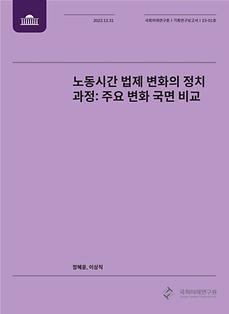
This study aims to analyze how the issue of working hours has been addressed in Korean society by focusing on the phases of change in legislation concerning the matter. The discussion has been approached from the mid-/long-term perspective by identifying the major phases through which the working hours issue has been dealt with politically. The goal has been to move beyond simply judging the pros and cons of measures taken in a particular context by a particular government administration.
We have divided the political process of working hours legislation into three main periods: (1) Formal Institutionalization (1953-1988), (2) Action and Reaction (1989-1997), and (3) Legal Institutionalization (1998-present). The process of legal transformation was characterized by (1) the nature of and agenda for reducing working hours (strengthening regulations) and making working hours more flexible (deregulation), (2) the venue (National Assembly parliament and other spaces) and main actors, and (3) whether it was an independent effort or part of some other agenda (collective labor relations law).
Chapters 1 and 2 introduce the research questions, background, and three dimensions of the timeline of this study, namely (1) the status of working hours, (2) establishment of an agenda, and (3) legislative changes. They also explain the organization of the study.
Chapter 3 analyzes the first period (1953-1988), when the form of labor hour legislation did not function effectively as a rule of law. Chapter 4 explores the period of action and reaction from 1989 to 1997. Major reforms were made for reducing working hours and making them more flexible during the legislative process.
Chapter 5 deals with the institutionalization of the working hours laws and regulations from 1998 to the present. Chapter 6 summarizes the chapter’s analyses and reconstructs news questions for the political process of working hours legislation.
The study presents the historical trends and political and social context in which the working hours issue has been addressed in Korean society over the mid-/long-term.